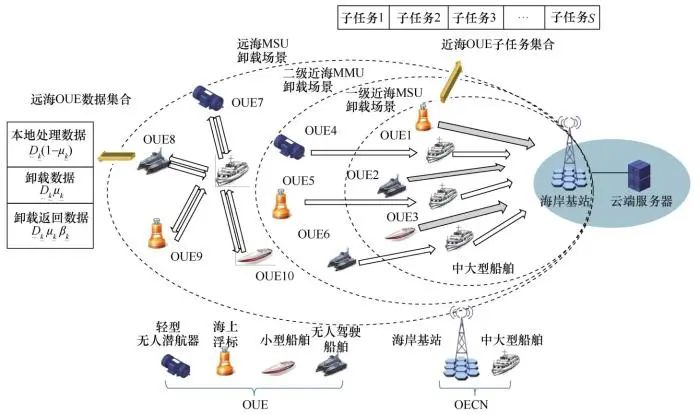

Click the blue text above to follow us!
Multi-Access Edge Computing Offloading Methods for Maritime Monitoring Sensor Networks
Su Xin1, Wang Ziyi1, Wang Yupeng2, Zhou Siyuan3
1 College of Internet of Things Engineering, Hohai University, Changzhou, Jiangsu 213002, China
2 School of Electronic Information Engineering, Shenyang Aerospace University, Shenyang, Liaoning 110136, China
3 School of Computer and Information, Hohai University, Nanjing, Jiangsu 211106, China
Abstract:
Multi-access edge computing (MAC) can effectively ensure low latency and high reliability in data transmission for maritime monitoring sensor networks (referred to as sensor networks) and various related maritime applications. In coastal scenarios, two offloading models are established: multi-user single-hop unicast (MSU) and multi-user multi-hop unicast (MMU), based on the distribution of edge computing resources. By separating the optimization objectives using mixed-integer nonlinear programming, transmission power is effectively allocated, and offloading decisions are made using an improved artificial fish swarm algorithm (AFSA). The results show that the proposed optimization algorithm can reduce network latency by nearly 19% compared to traditional solutions. In offshore scenarios, a distant sea MSU offloading model is established, and a reasonable channel allocation algorithm is proposed based on network connectivity probability. The results indicate that when network connectivity time is sufficient, the number of sub-channels allowed for allocation can be increased, reducing network latency; when network connectivity time is limited, the number of maritime user devices to be offloaded can be controlled to ensure network transmission latency.
Keywords: Maritime monitoring sensor networks; Multi-access edge computing; Artificial fish swarm algorithm; Channel allocation
Citation format:
Su X, Wang Z Y, Wang Y P, et al. Multi-access edge computing offloading in maritime monitoring sensor networks[J]. Chinese Journal on Internet of Things, 2021, 5(1): 36-52.
SU X, WANG Z Y, WANG Y P, et al. Multi-access edge computing offloading in maritime monitoring sensor networks[J]. Chinese Journal on Internet of Things, 2021, 5(1): 36-52.
1 Introduction
2 Related Work
2.1 Single User Multi-Access Edge Computing
2.2 Multi-User Multi-Access Edge Computing
3 Edge Computing Offloading in Maritime Monitoring Sensor Networks
3.1 Architecture of Maritime Monitoring Sensor Networks

3.2 Edge Computing Offloading in Coastal Scenarios
Tel:010-81055683
010-81055483
010-81055691
E-mail:[email protected]
http://www.infocomm-journal.com/wlw
http://www.wlwxb.com.cn
